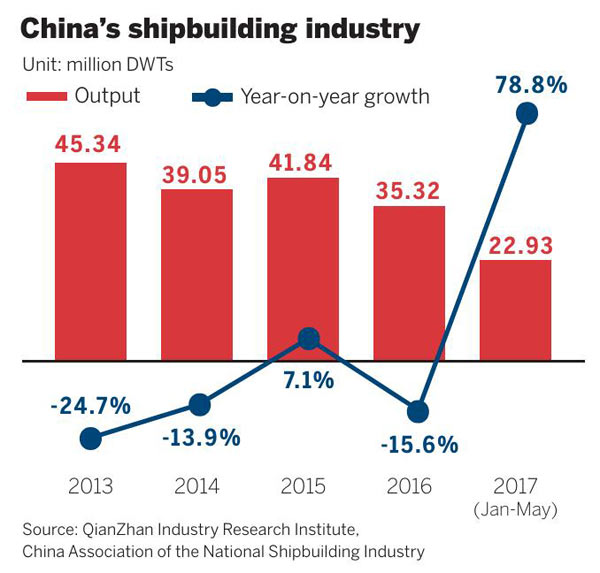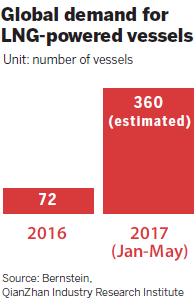Even though many Chinese shipyards went bankrupt and remerged last year, the operational revenue of Hudong-Zhonghua was 18.35 billion yuan, up a bit from 2015. The new course adopted by shipyards in Jiangsu, Zhejiang, and Shanghai is largely the result of many global shipping companies reporting losses since 2008 because of overcapacity, declining global trading volume, falling ship prices, surging costs in labor, energy, steel, ship parts and maintenance. Eager to enhance its earning ability, Nantong COSCO KHI Ship Engineering Co, a 50:50 shipbuilding joint venture between China COSCO Shipping Corp Ltd and Japan's Kawasaki Heavy Industries Ltd, also aims to have an annual production capacity of two LNG carriers by 2018. In addition to LNG carriers, another Chinese shipyard, Shanghai Waigaoqiao Shipbuilding Co Ltd, is building a cruise liner, the first such vessel to be built on the Chinese mainland. It is expected to be delivered to a Hong Kong-based buyer in 2023, marking a milestone in the evolution of the country's shipbuilding industry. The as-yet-unnamed ship will be built at Shanghai Waigaoqiao Shipbuilding Co, a joint venture between CSSC and Italy-based Fincantieri SpA, the world's largest builder of cruise ships. Waigaoqiao Shipbuilding, another CSSC subsidiary, announced earlier this month it will inject another 720 million yuan into its cruise liner building technology company to improve its research and development strengt The Hong Kong client will order two new liners from the CSSC-Fincantieri joint venture. It has an option to order four more home-built ships. "The construction of China's first cruise ship will help improve various sectors of the domestic shipbuilding ecosystem, which will become part of the global supply chain," said Dong Liwan, a shipbuilding professor at Shanghai Maritime University. Even though Chinese shipyards have recovered a bit in the first half of this year, Dong said competition with South Korean competitors will be fierce in the long term, especially at a time when the whole industry is witnessing price wars and demanding advanced ships with more functions. South Korean shipyards received 34 percent of global orders in the first half of this year, to top the world's country-wise list for the industry's giants, according to British shipping and offshore market intelligence provider Clarkson Research Services Ltd. Three South Korean companies including Hyundai Heavy Industries Co and Hyundai Samho Heavy Industries Co, received 72 ship orders, including 60 for oil tankers and very large crude carriers or VLCCs, with a total value of $4.2 billion. Meantime, Samsung Heavy Industries Co received orders worth $4.8 billion to build LNG carriers, mega-container ships and VLCCs from shipowners in Southeast Asia and Europe.
本文来自网络,不代表英语网立场,转载请注明出处:https://yingyuw.cn/en/11215.html
|
建设新海洋经济
Even though many Chinese shipyards went bankrupt and remerged last year, the operational revenue of Hudong-Zhonghua was 18.35 billion yuan, up a bit from 2015.The new course adopted by shipyards in Jiangsu, Zhejiang, and



 h.
h.




